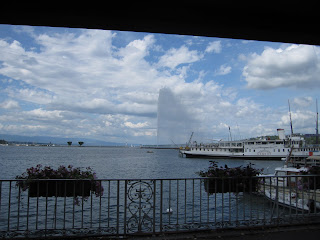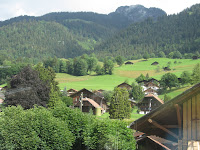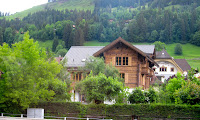The United Nations
Outside the building stands a huge chair (two stories high) with a broken leg. It's a dramatic reminder of the crippling damage done by land mines.

Inside, a tour guide took us through part of the UN building, including what was originally the League of Nations building and the new section - in total a huge building - larger than the pentagon.

 The guide explained the various missions: peace and security, development, human rights, humanitarian affairs (including refugees, floods, land mines, food supply) and international law. She showed us meeting rooms, large and small, and pointed out some of the gifted art, much of which sends provocative messages.
The guide explained the various missions: peace and security, development, human rights, humanitarian affairs (including refugees, floods, land mines, food supply) and international law. She showed us meeting rooms, large and small, and pointed out some of the gifted art, much of which sends provocative messages.What hit us was the realization that hundreds of people, representing 191 countries, are devoting countless hours to trying to bring peace to our world. The proclamations and pronouncements that emerge from the various meetings outline solutions. Why, then, do we have such a hard time protecting our environment, feeding the hungry, preventing war???
The Red Cross
 Our second visit was to the headquarters of the International Red Cross. A museum with videos and artifacts tells the history of the organization, highlights some of the people whose commitment has resulted in the good work of the RC, and describes the hundreds of interventions over the years.
Our second visit was to the headquarters of the International Red Cross. A museum with videos and artifacts tells the history of the organization, highlights some of the people whose commitment has resulted in the good work of the RC, and describes the hundreds of interventions over the years. We learned about Henry Dunant who is credited with starting the Red Cross in 1863. Overcome with anguish at seeing wounded soldiers left to die on the battlefield, he lobbied long and hard to convince governments that medical intervention must be allowed. It was his proposals that led to the 1864 Geneva Conventions. That was the beginning of Red Cross involvement in wars and other disasters. Taken together, the number of volunteers who have responded is overwhelming and inspiring.
Among the things we learned was how the Red Cross and Red Crescent relate. Although the "red cross" symbol was selected as a reverse of the flag of Switzerland, where the organization was born, branches in Moslem countries were uncomfortable with the cross, seeing it as a symbol aligned with Christianity. In 1929 the symbol of the red crescent, used by the branches of the organization in Moslem countries, was recognized (as was the red crystal - considered a neutral symbol -in deference to Israel - in 2006).
- Posted using BlogPress from my iPad
Location:Geneva - UN, Red Cross













































